Hyundai Ioniq: Front View Camera System / Repair procedures
| Service Point Target Auto Calibration (SPTAC) |
When you need calibration :
| –
| Front view camera is removed and mounted |
| –
| Replace front view camera with a new one |
| –
| Windshield glass changed |
| –
| Front view camera coupler of the windshield glass is deformed |
Service Point Target Auto Calibration (SPTAC)
Front view camera SPTAC provides the method for the service technician to calibrate the camera by aligning the calibration target (SST: 09890-3V100) with the vehicle on a level ground.
If the calibration is not completed within the specified tolerance Front View Cemera "System Out of Calibration" DTC is indicated.
| 1. | Method for Correct Alignment of Calibration Target In order to complete the calibration of the front view camera successfully, install the calibration target as follows: | –
| Install the target (SST: 09890-3V100) vertical to the ground and from the camera referring to the below tolerance angle. |
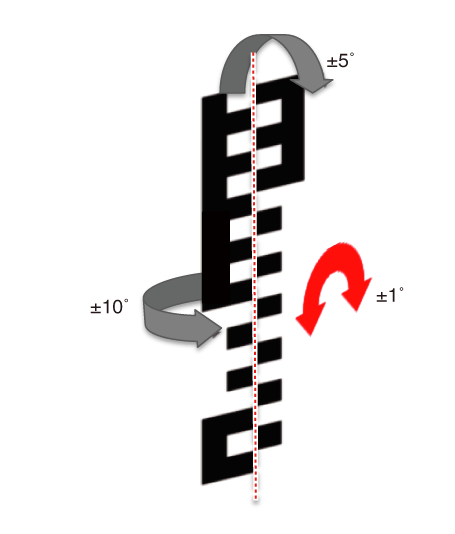

The tolerance ± 1° for the left and right gradient is very important and is sensitive to the flatness of the ground. Install the compensator vertically using the Level Laser (SST: 09958-3T060 or 09964-C1200). Arrange the Level Laser (A) on the center of the vehicle by installing it on the roof center above the vehicle's front windshield (same for both short and long distance calibrations) . 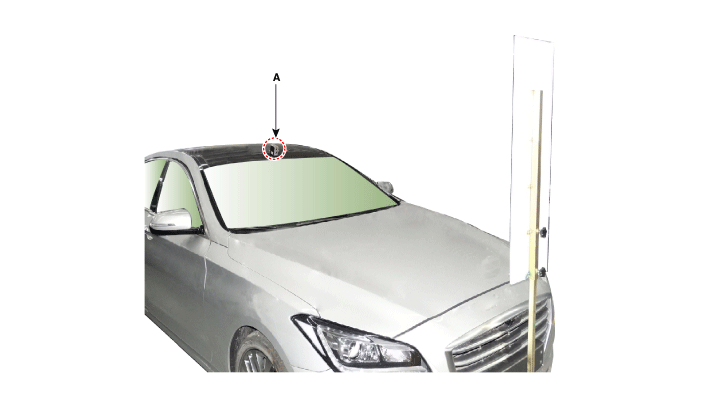
Have the laser illuminate starting from the roof center and to all the way to the center of the target, passing through the emblem center. 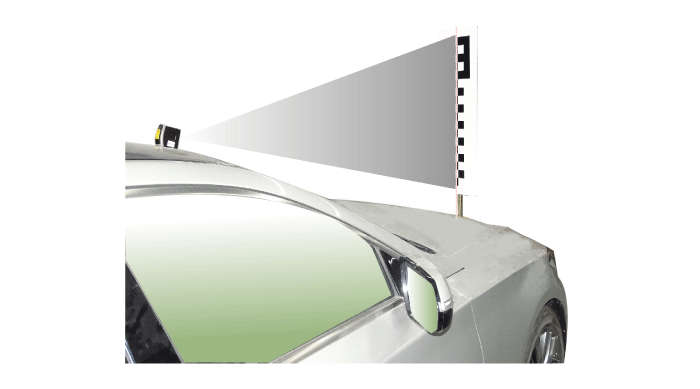
The level laser must be set to 'ON' and the holding (locking) function is not used. |
Target is mounted to rigid backer material to maintain flatness requirements. | –
| Target has reflective (not faded or poorly painted) markings that are unlike from lane features. |
| –
| Target is 30 cm wide and 100 cm tall. |
| –
| Mounting area must NOT have cross hatch patterns or textual markings near the target. |
| –
| Target should be well lit for optimal performance using non-fluctuating illumination. There shall be no continuous shadows cast on the target. |
| –
| The light should be directed toward the target front and the target front should be brighter than the target rear and target. |
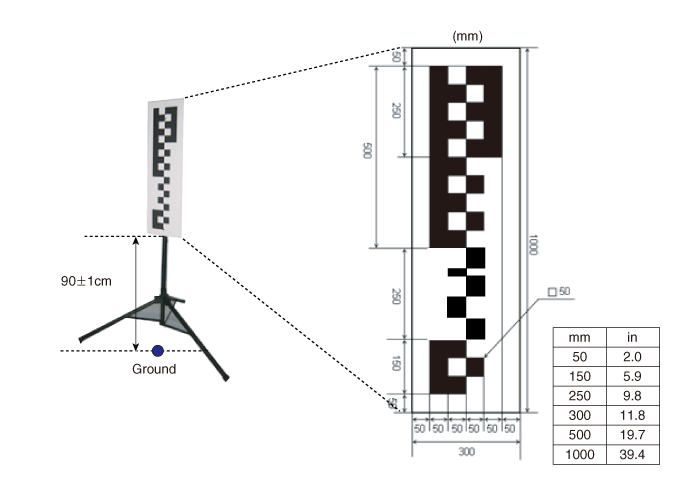
|
|
| 2. | Service Point Target Auto Calibration (SPTAC) Procedure | 1) | It is recommended to check vehicle toe-in and tire pressure levels to ensure proper alignment of the camera to the "world" before proceeding with calibration. The vehicle to run the calibration routine is to be at nominal production loading capacity. |
| 2) | Windshield must be clean and silk-screen checked so that there is no blockage of the camera. |
| 3) | Service technician connects the diagnostic connector and starts the vehicle. The front view camera should not be activated by pressing the switch. |
| 4) | The service calibration routine may not run correctly if any system level fault is active. |
| 5) | If working with a replacement ECU : the service technician initiates the SPTAC Reset configuration. |
| 6) | Service technician either aligns the vehicle to the target or the target to the vehicle. a. Locate the bottom of the target 90cm from the ground (max. tolerance : 1cm). b. Locate so that the central axis of the target and the central axis of the vehicle match (max. tolerance : 3cm). c. Locate the short-distance target (A) so that it adheres by 0cm (B) to the bumper front (max. tolerance : 5cm). d. The location of the long-distance target (C) is 100cm (D) before the bumper (max. tolerance : 5cm). 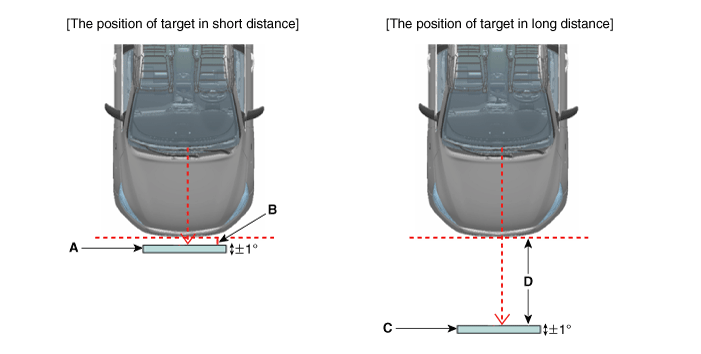
|
| 7) | Select Camera Calibration under Option of Global Diagnosis System (GDS). 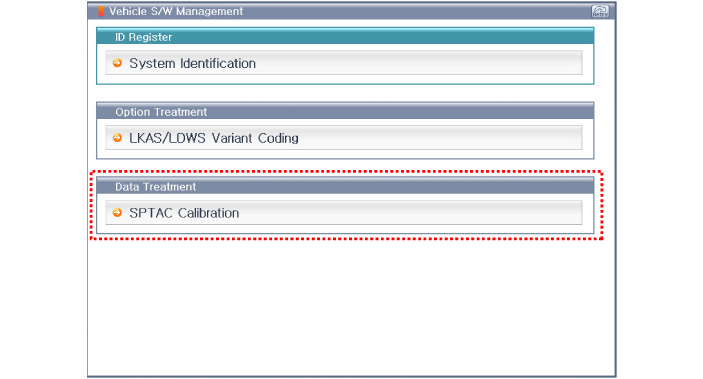
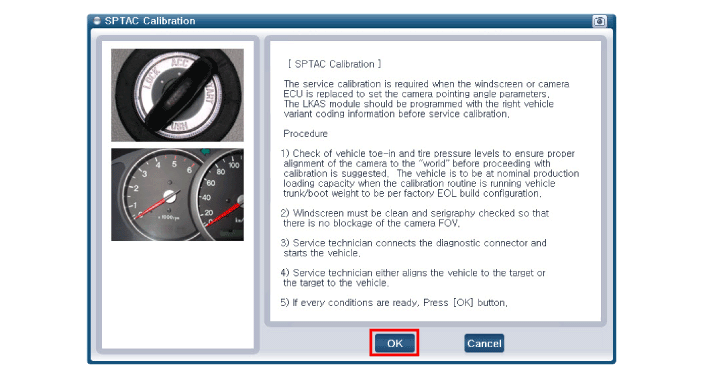
|
| 8) | The technician should complete the short-distance calibration after checking the target location and "OK" message on the GDS. 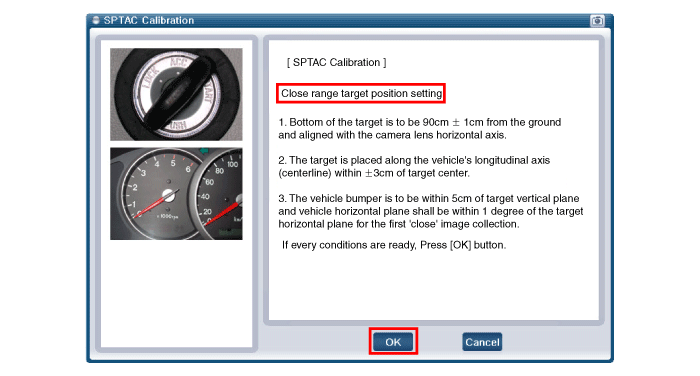
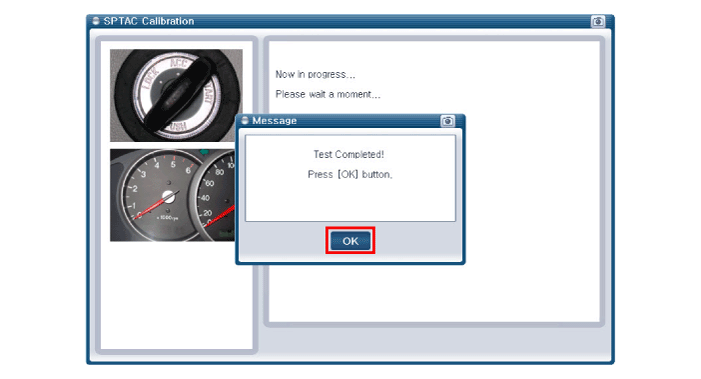
|
| 9) | The technician should complete the long-distance calibration after checking the target location and "OK" message on the GDS (conduct the calibration twice : short and long distances). If the distance 100 ± 5 cm (39.4 ± 2 inch) is different from the distance indicated on the GDS, calibrate it according to the value indicated on the GDS. 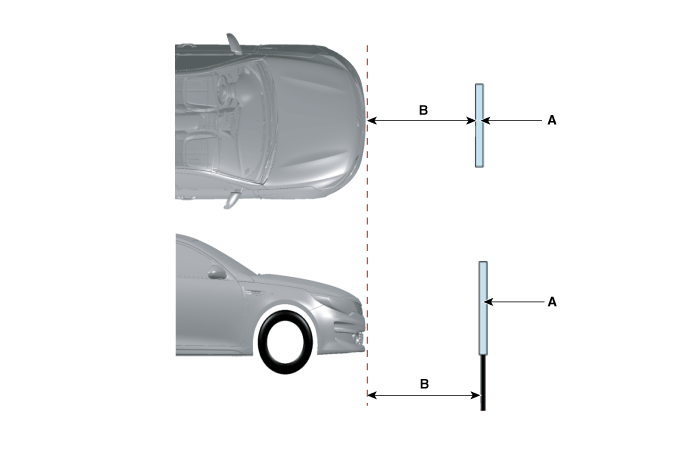
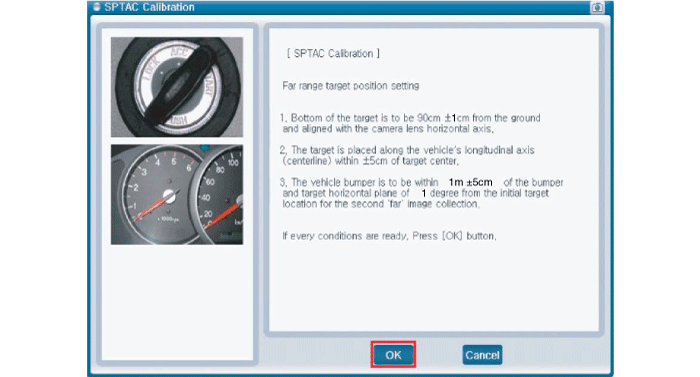
|
|
|
Test Drive
| –
| Be sure to perform test drive to check for normal operation after performing calibration. |
| –
| Drive on straight road (of longer than 500 m) with 2 white or yellow lane marks at speed of over 60km/h (64mph), and check for the alert as you intentionally steer close to the lane mark. |
| –
| LKA operates properly if the lane mark segment space is less than 8 m. |
| –
| Perform test drive on car-only road or on a highway. |
|
The LKA may not activate properly in the following conditions The LKA may not activate properly when: | –
| It is difficult to distinguish the lane from the road due to dust built up on the lane. |
| –
| It is difficult to distinguish the color of the lane line from the road. |
| –
| There is a mark that looks like a lane line near the line. |
| –
| The lane line is indistinct or damaged. |
| –
| The number of lanes increases or decreases or the lane lines are crossing (driving through toll plaza, toll gate, road merging or dividing area, etc.). |
| –
| There are more than two lane lines. |
| –
| The lane is very wide or narrow. |
| –
| The lane is not visible due to snow, rain, stain, a puddle or other factors. |
| –
| Shadows of objects (median strip, guard rail, noise barriers, etc.) surrounding the road are casted on the lane. |
| –
| The lane is congested or it is replaced by a structure in a construction area. |
| –
| There is a indication on the road surface such as crosswalk or road signs. |
| –
| The lane inside the tunnel is covered with dust or oil. |
| –
| The brightness outside changes suddenly such as when entering or exiting a tunnel. |
| –
| The head lamps are not on at night or in a tunnel, or light level is low. |
| –
| There is a boundary structure. |
| –
| Light such as street light, sunlight or oncoming vehicle light reflects from the water on the road. |
| –
| Driving with the sun in front of you. |
| –
| Driving on the bus-only lane or on the left/right of the lane. |
| –
| The lane suddenly disappears at certain locations such as at the intersection. |
| –
| The distance from the vehicle ahead is extremely short or that vehicle drives hiding the lane line. |
| –
| Driving on a steep grade or a sharp curve. |
| –
| The vehicle vibrates heavily. |
| –
| The surrounding of the inside rear view mirror temperature is high due to direct sun light. |
| –
| The lens or windshield is covered with foreign matter. |
| –
| Tthe sensor cannot detect the lane because of fog, heavy rain, or heavy snow. |
| –
| The windshield is fogged by humid air in the vehicle. |
| –
| Putting something on the crash pad. |
|
The LKA may not activate properly in the following conditions: | •
| The LKA is a system to prevent lane departure and assist steering. In any case, do not rely on the steering assist system, and the driver must take the necessary precautions to determine safety matters. |
| –
| Driver is responsible for being aware of surroundings and steering the vehicle for safe driving practices. |
| –
| Do not steer the steering wheel suddenly when the steering wheel is being assisted by the system. |
| –
| LKA helps prevent the driver from moving out of the lane unintentionally by assisting the driver’s steering. |
| –
| LKA is not working if the camera cannot detect the lane or if the vehicle speed does not exceed 64km/h(40mph), |
| –
| Do not disassemble front view camera temporarily for tinted window or attaching any types of coatings and accessories. |
| –
| Do not allow any water or liquid to contact the front view camera. |
| –
| Do not remove the front view camera parts and do not damage the front view camera by a strong impact. |
| –
| Do not put objects that reflect light on the crash pad. |
| –
| Excessive noise can make the LKA alarm sound unheard. |
|
High Beam Assist
The system may not operate normally in the below conditions. | –
| When the light from the oncoming or front vehicle is not detected because of lamp damage, hidden from sight, etc. |
| –
| When the lamp of the oncoming or front vehicle is covered with dust, snow or water. |
| –
| When the light from the oncoming or front vehicle is not detected because of exhaust fume, smoke, fog, snow, etc. |
| –
| When the front window is covered with foreign matters such as ice, dust, fog, or is damaged. |
| –
| When there is a similar shape lamp with the front vehicle’s lamps. |
| –
| When it is hard to see because of fog, heavy rain or snow. |
| –
| When the headlamp is not repaired or replaced at an authorized dealer. |
| –
| When headlamp aiming is not properly adjusted. |
| –
| When driving on a narrow curved road or rough road. |
| –
| When driving downhill or uphill. |
| –
| When only part of the vehicle in front is visible on a crossroad or curved road. |
| –
| When there is a traffic light, reflecting sign, flashing sign or mirror. |
| –
| When the road conditions are bad such as being wet or covered with snow. |
| –
| When the front vehicle’s headlamps are off but the fog lamps on. |
| –
| When a vehicle suddenly appears from a curve. |
| –
| When the vehicle is tilted from a flat tire or being towed. |
| –
| When the LDW/LKA warning light illuminates. |
| –
| Replace MFC with a new one |
| –
| Windshield glass changed |
|
DescriptionBlcok DiagramFunctions of Front View CameraFront View Camera supports the following functions using the information (lane, light source, vehicle and pedestrian) detected by the front view camera and the vehicle's signal information (CAN communication)...
Other information:
D..
All tire pressures (including the spare) should be checked when the tires are
cold. "Cold tires" means the vehicle has not been driven for at least three hours
or has been driven less than one mile (1.6 km).
Warm tires normally exceed recommended cold tire pressures by 4 to 6 psi (28
to 41 kPa)...
Categories
Folding the rear seat
The rear seatbacks can be folded to facilitate carrying long items or to increase
the luggage capacity of the vehicle.
WARNING
Never allow passengers to sit on top of the folded down seatback while
the vehicle is moving. This is not a proper seating position and no seat belts
are available for use. This could result in serious injury or death in case
of an accident or sudden stop.
Objects carried on the folded down seatback should not extend higher
than the top of the front seatbacks. This could allow cargo to slide forward
and cause injury or damage during sudden stops.
read more
 Description and operation
Description and operation















